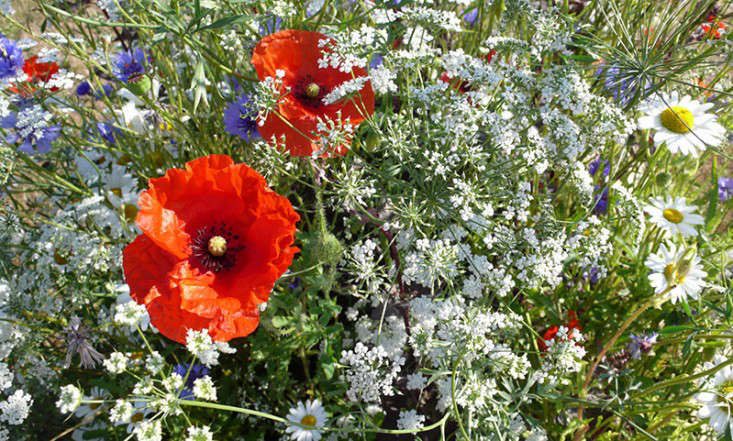Poppy, Papaver: “The Plant of Joy”
A symbol of gods and nations, of sleep and death, of peace and rebirth–poppies have captured the popular imagination and fancy of humans since the earliest days of civilization, and perhaps before. Used by the ancients as a powerful remedy for malaise and pain, the poppy’s medical applications remain vital to this day. And of course, we loved those charming little seeds in our cakes and muffins. But for more than any of these reasons, humans worship those bold, bodacious blooms for the color and drama they lend to our gardens.
Above: Photograph by Sylvia Linsteadt for Gardenista. For more of this garden, see Honey Grove Cottage in the Firs, on Vancouver Island.
A wildflower, poppies come in virtually every color, from the scarlet red to the pink blush, and the range in height from 6 inches to a few feet tall. Some have giant blooms, such as the Iceland Poppy P. nudicaulewith flowers that measure 7 inches across. Their petal structures range from relatively simple–four to six petals in a single layer–to double and even more elaborate peony forms.
Above: Photograph by Kendra Wilson.
Common or “Corn” (from the Greek “korn” meaning “grain”) poppies Papaver rhoeas are so named because this crimson wildflower often appears in fields throughout Europe. In fact in ancient Greece poppies became a symbol of Demeter, Goddess of the Fertility and the Harvest.
The association of Corn poppies as a symbol of peace and remembrance dates to WWI, when self-sewn poppies were the only life that seemed to thrive in the battle scarred landscape around the trenches. John McCrae, a Canadian soldier, was so moved by the sight of this plucky red flower blooming against a scene of death that he wrote a poem, In Flanders Field,” in honor of the dead. For this reason Corn poppies are also known as Flanders Poppies. To this day poppy buttons are still worn as a memorial to honor fallen war heroes.

Above: Although all poppy seeds contain trace amounts of narcotics, Opium is derived only from the seed pods of the opium poppy or Papaver somniferous, which has the highest concentration of the drug. Photograph by Marie Viljoen.
Though archeological evidence suggests that people have been using poppy seeds to alleviate pain and grief since the Stone Ages, the first written record of poppies dates to ancient Sumeria in 4000 BC. The ancient Sumerians called it “hul gil” plant of joy. Since then ancient civilizations such as the Persians, Egyptitans, Greeks, and Romans cultivated the opium poppy for medicinal purposes and for use in religious ceremonies and to induce sleep. (Remember the enchanted field of poppies in The Wizard of Oz?) Its use spread to Arabia and China via the Silk Road.
Today opium derived pain relievers are still used in the form of morphine, codeine, and oxycodone. Of course opium is also a powerfully addictive drug, so the mass cultivation of opium poppies is highly regulated in the U.S.
Most poppy seeds used in cooking are also from Papaver somniferous. But the amounts are so small as to render them harmless.
Above: Photograph by Justine Hand. For more, see Secret Garden: At Home with Marnie on Cape Cod.
The iconic poppy has been adopted as a symbol not only of the Gods and heroes, but also of nations and states. Eschscholzia californica California poppy, shown here, is the official state flower of Califonia. Native to the southwestern US and Mexico, this hardly wildflower is perfect for dry soil conditions such as container and rock gardens. It’s an annual, but self sows so easily that it acts like a perennial.

Above: Lisa Przystup of James’s Daughter Flowers recently showed Erin how to use poppies in an arrangement in DIY: Reclaiming an Outmoded Cut Glass Vase with James’s Daughter Flower. Photograph by Erin Boyle.
Of course the bold blooms of poppies are a perfect complement to any dramatic arrangement. When cutting directly from the garden, pick buds (not open flowers–let them open in a vase). Select buds that stand straight and show a bit of color. Cut poppies produce a milky sap, which contains some latex, so those who are allergic may want to wear gloves. Seal the stems with a burning match to prolong the cut flower’s shelf life.
Above: Oriental poppies at Wiveton Hall. Photograph by Kendra Wilson. For more, see Hotel Visit: Rent a Wing of Wiveton Hall in Norfolk.
Cheat Sheet:
- Herbaceous wildflowers that blooms in late spring and early summer, poppies can be either annual–such as the Corn or Flander’s poppy Papaverrhoeas–or perennial, such as the Alpine poppy P. alpinum, Iceland Poppy P. nudicaule, or Oriental poppy P. orientale.
- Poppy seeds germinate in cool weather. Sow seeds in early spring in colder climes (in fall for zone 7 and above).
- Mix seeds with sand and spread on top to the dirt. Do not bury, but cover with a fine layer of soil. After seeds germinate, thin to 6 to 10 inches apart.
- For bouquets, cut buds before they open and singe the stem with a flame.

Above: Papaver ‘Black Peony.’ Photograph by Annie’s Annuals.
Keeping it Alive:
- Poppies require full sun–at least six to eight hours a day–to bloom well.
- Soil should be well-drained and neutral with a pH of 6.5 to 7.0.
- Established plants are fairly drought resistant. Water 1 inch per week when budding and blooming. Do not over water as this can rot the roots.
- To fertilize, side dress with compose or manure in spring.
- In winter, evergreen boughs will keep the crowns from being pulled out of the soil.
For more poppy inspiration, see Bouquet of the Week: Winter Sunshine with Artichokes and Poppies.












Have a Question or Comment About This Post?
Join the conversation